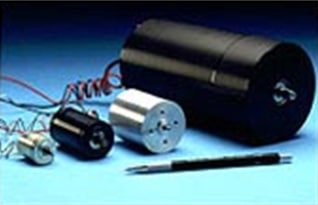
Brushless servo motors resemble a dc shunt motor turned inside out. DC servo motors feature permanent magnets, located on the rotor, or a wound rotor excited by DC voltage through slip rings, requires that the flux created by the current carrying conductors in the stator rotate around the inside of the stator in order to achieve servo motor action. The brushless servo motor features a rotating field that is obtained by placing three stator windings around the interior of the stator punching. The windings are then interconnected so that introducing a three-phase excitation voltage to the three stator windings (which are separated by 120 electrical degrees) produces a rotating magnetic field. Brushless servo motor construction speeds heat dissipation and reduces rotor inertia.
The brushless servo motor features permanent magnet poles on the rotor, which are attracted to the rotating poles of the opposite magnetic polarity in the stator creating torque. As in the DC shunt motor, the DC brushless servo motor offers torque, which is proportional to the strength of the permanent magnetic field and the field created by the current carrying conductors. The magnetic field in the DC servo motor stator rotates at a speed proportional to the frequency of the applied voltage and the number of poles.
The rotor rotates in synchronism with the rotating field, thus the name synchronous motor is often used to designate servo motors of this design. More recently, this servo motor design has been called an electrically commutated motor (ECM) due to its similarity to the dc shunt motor. In the DC shunt motor, the flux generated by the current carrying winding (rotor) is mechanically commutated to stay in position with respect to the field flux. In the synchronous DC servo motor, the flux of the current carrying winding rotates with respect to the stator; but, like the DC motor, the current carrying flux stays in position with respect to the field flux that rotates with the rotor. The major difference is that the synchronous dc servo motor maintains position by electrical commutation, rather than mechanical commutation.
Sinotech can ensure excellent Brushless Servo Motors from China, Taiwan and Korea and is very price competitive. Sinotech Motors has manufactured QS-9000 and ISO certified Brushless Servo Motors in China, Taiwan and Korea for over 15 years. Sinotech Motors is dedicated to delivering brushless servo motors from China, Taiwan and Korea to you at lower prices but the same quality, service and terms as a domestic supplier.
Sinotech Brushless Servo Motors are engineered in the U.S. and manufactured in China, Taiwan and Korea.
